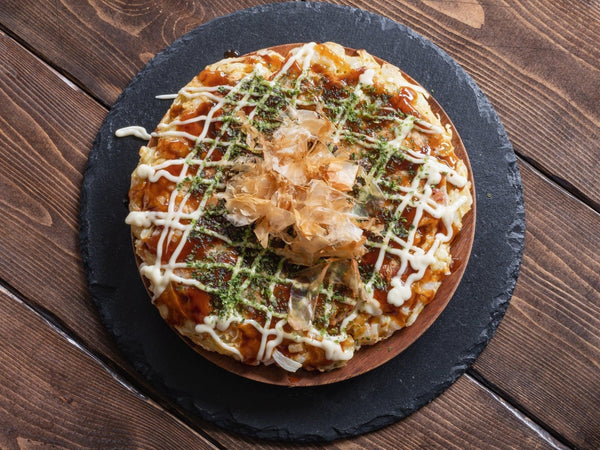
Jump to:
Amid the expanse of Japan’s modern gastronomical delights, stands a dish that’s gaining in popularity among Japanese and non-Japanese alike: okonomiyaki.
Literally translating to "grilled as you like it,” this savory pancake-like dish captures the essence of Japanese cuisine in its adaptability, simplicity and flavor. Combining a multitude of savory ingredients in a single, satisfying pancake/crepe format, okonomiyaki offers a delightful insight into Japanese street food culture.
In this article we’ll discover okonomiyaki’s history, regional variations (notably Hiroshima vs. Osaka!) and the secret behind its undying popularity. For those curious to make okonomiyaki at home, later on we’ll cover how you can do just that with an okonomiyaki recipe!
What Is Okonomiyaki?

Often described as a Japanese savory pancake, crepe or even pizza, okonomiyaki is a delightful ensemble of ingredients, bound together with a flour and cabbage-based batter. Cooked on a griddle, it's a popular street food (often served in okonomiyaki restaurants too) and an essential part of Japan's "konamono" flour-based cuisine.
The beauty of okonomiyaki lies in its flexibility. As the name suggests, what goes into the pancake is based on individual preference. “Okonomi" means "as you like" in Japanese. The base typically consists of wheat flour (there is a special okonomiyaki flour that Japanese will use at home), eggs, shredded cabbage, and a form of protein – often pork belly slices, seafood, or even cheese.
The okonomiyaki pancake (or crepe, if you prefer) is skillfully grilled until it achieves a balance of a crispy exterior and a fluffy, well-cooked center. Okonomiyaki is then slathered with a generous spread of tangy, umami-rich okonomiyaki sauce and a sprinkle of "aonori" (green seaweed flakes) and "katsuobushi" (dried, shaved bonito). The result is a multi-layered medley of tastes and textures.
Whether enjoyed as a fulfilling lunch, a casual dinner or a late-night snack – in a restaurant or at a street stall – okonomiyaki offers a unique way to explore a vast range of flavors in a hearty, comforting dish.
What Are The Regional Differences In Okonomiyaki (Osaka, Hiroshima & Beyond)?
Another driving factor of okonomiyaki’s popularity resides not just in the freedom of ingredient choice, but also in its regional diversity. The two most noteworthy styles of okonomiyaki come from Osaka and Hiroshima, each offering a unique interpretation of the dish.
Osaka Okonomiyaki: Where It All Began

Osaka-style okonomiyaki, also known as Kansai-style (seen in neighboring Kyoto, Kobe, etc), is arguably the more commonly seen version of the two. Ironic, perhaps, seeing that the food most often linked with Osaka is not okonomiyaki, but rather takoyaki (which are also a batter-and-sauce concoction, but those are made with octopus and rolled in a ball shape). Osaka is said to have invented the modern dish of okonomiyaki, or at least to have coined the term “okonomiyaki.” That’s all part of the (usually good-natured) debate, of course.
In Osaka okonomiyaki, all the ingredients – batter, cabbage, meat, and other additions – are mixed together before being cooked, much like a savory pancake. Usually, the chosen protein (e.g. pork) is incorporated on top of batter as it cooks, with the finished dish being topped with okonomiyaki sauce, mayonnaise, aonori and katsuobushi. Another common ingredient in Osaka okonomiyaki is the addition of “yamaimo” or grated Japanese mountain yam (if you’ve eaten taro root and/or yuca, yamaimo is similar in appearance, texture and subtle flavor). Yamaimo has a slight stickiness with a bit of crunch, allowing it to hold the Osaka okonomiyaki together nicely while providing an added textural experience.
Osaka okonomiyaki also includes tenkasu, which are bits of fried tempura that are left over after frying the main ingredients; and beni-shoga or red pickled ginger (not the same ginger as in sushi, though). The tenkasu adds a textural component, while the beni-shoga balances the sweetness with some acidity. Osaka okonomiyaki sauce is more piquant than both the sauces available in Tokyo as well as the Hiroshima okonomiyaki sauce. Interspersed with the okonomiyaki sauce is Japanese mayonnaise, usually Kewpie Mayo. This combination makes for a creamy, tangy flavor that nicely complements the textural experience of Osaka okonomiyaki. The most common protein in Osaka okonomiyaki is sliced pork, usually pork belly. It can be interchanged with other proteins, though – if making this dish at home, feel free to swap out for chicken, shrimp, squid, or tofu.
Osaka okonomiyaki can be found in both street stalls and market stalls, as well as in restaurants around Osaka and the Kansai that specialize in Osaka okonomiyaki. If you’re traveling in Kyoto and eating okonomiyaki, it’s likely to be Osaka okonomiyaki; the same generally holds true when you’re in Tokyo. Osaka okonomiyaki isn’t the only version found across the country, though; in Tokyo, Kyoto, and even Osaka, you might also encounter Hiroshima okonomiyaki.
Hiroshima Okonomiyaki: Layers Of Goodness

Hiroshima might not have been the inventors of okonomiyaki, but they can surely lay claim to one of the best-known versions of this dish: Hiroshima okonomiyaki. This dish was commonly eaten in the years following the tragic bombing of Hiroshima when protein was scarce and a need for filling, comfort food grew. Hiroshima okonomiyaki filled that gap and filled the bellies of many in the region. That’s a big reason why people from Hiroshima are proud of their culinary heritage, as it parallels a resilience that allowed them to forge ahead and once again grow and prosper.
In today’s Hiroshima okonomiyaki, the batter is cooked thin and topped with a mound of cabbage, bean sprouts and other ingredients; followed by noodles (either yakisoba or udon); and finally crowned with a generous layer of fried egg and a topping of okonomiyaki sauce. The result is a considerably heftier, multi-textured variant of Hiroshima okonomiyaki that is both filling and rich in flavors.
Hiroshima okonomiyaki (also called “Hiroshima-yaki” in Kansai and other regions of Japan, though some from Hiroshima might take umbrage with this term) features a sauce that is sweeter than that of its Osaka cousin. Visually, Hiroshima okonomiyaki is said by some to be more photogenic, thanks to its layering of ingredients enabling a cross-section photo op. When finished and served, Hiroshima okonomiyaki will reveal the noodles, cabbage and bean sprouts as visibly distinct features on the outside (even more so if cut for a cross-section). This contrasts with Osaka okonomiyaki, which is more of a uniform melange due to pre-mixing the batter and ingredients before cooking.
There is a method to the layering, too. As the Hiroshima okonomiyaki cooks down, the cabbage starts to heat up (more cabbage can be added in later for texture too). Instead of just mixing in all the ingredients at the outset, the Hiroshima okonomiyaki chef has to be mindful of how the ingredients are layered to ensure a proper cook-through. Hiroshima okonomiyaki fans will argue that this cooking technique requires more prowess and focus, ergo their version of okonomiyaki is the best. Osaka okonomiyaki fans might just disagree.
Which Is Better: Hiroshima Okonomiyaki Or Osaka Okonomiyaki?

Though each method has its dedicated fan base, both styles – the mixed, pancake-like Osaka okonomiyaki or the layered, noodle-rich Hiroshima okonomiyaki – are not to be missed during your journey in Japan. Hiroshima okonomiyaki fans and Osaka okonomiyaki fans will debate their creations much like fans of the Hiroshima Carp and Hanshin Tigers debate their baseball. In the end, of course, most would (even if begrudgingly and after enough beer) agree that “we’re all family” – and that these cousins in the okonomiyaki culinary scene can both share a special place in the eyes (and mouths) of the dining public.
How Is Okonomiyaki Made? What Are The Star Ingredients?

Creating okonomiyaki is a lot like making a pancake or crepe, in that it involves batter spread onto a flat-top grille.
Instead of a sweet filling, however, okonomiyaki batter is combined with an assortment of savory ingredients. The base of okonomiyaki typically comprises wheat flour, eggs, grated "yamaimo" (a type of Japanese yam), and shredded cabbage. Protein additions vary widely, from traditional choices like pork belly or octopus to more modern toppings like cheese, kimchi, chicken, tofu, or mochi.
After mixing the okonomiyaki batter and fillings, a dollop is spread onto a hot griddle or a teppan plate and grilled until both sides turn a lovely golden brown. The cooked concoction is then brushed with the distinctive okonomiyaki sauce, a thick, sweet-savory sauce that adds an extra layer of umami goodness to the dish. A drizzle of Japanese mayo, a sprinkle of aonori, and a generous scattering of katsuobushi top off any okonomiyaki worth its salt, making it a feast both for the eyes and the palate.
History Of Okonomiyaki: How Did It Come To Be?
The exact origin of okonomiyaki is hard to trace, but its concept – a simple, versatile dish prepared with readily available ingredients – aligns with the basic philosophy of many traditional Japanese foods.
Its earliest form harkens back to the Edo period (1603-1868), where a dessert called "Funoyaki" – a crepe-like treat served at festivals – was popular. During the more recent Taisho era (1912-1926), a transition toward a more savory variant occurred, with street vendors starting to add ingredients such as cabbage and seafood to the batter. This version is thought to be the precursor of the modern okonomiyaki.
The okonomiyaki dish we are familiar with today, however, didn't come into existence until after World War II. Food shortages led to a rise in simple, cost-effective dishes that could be easily prepared and customized with different ingredients. As the economy recovered and food became more abundant, the okonomiyaki recipe evolved, incorporating a variety of additions based on regional preferences and seasonal availability.
Nowadays, okonomiyaki is celebrated for its versatility and comforting taste, symbolizing resilience, adaptability, and the Japanese culture’s passion for good, hearty food.
Where To Eat Okonomiyaki In Japan

Being Kansai-based, we might have a slight bias. But really, there's no better place to start savoring the authentic taste of okonomiyaki than in its home region. Osaka, the birthplace of okonomiyaki, is teeming with eateries serving this delightful dish.
In fact, just by searching Google Maps for okonomiyaki nearby, you’d be hard-pressed to find a “bad” or even “mediocre” version of okonomiyaki in this city whose motto is “eat until you drop.” Some okonomiyaki shops and stalls do stand out, of course… including:
Mizuno: Located in Osaka's bustling Dotonbori area, Mizuno is a long-standing okonomiyaki joint known for their yam-based batter and curated ingredients. Plus it’s a Bib Gourmand entry in the famed Michelin guide.
Other noteworthy Osaka okonomiyaki shops include Sakaba, Moegi and Dontaku Doyama.
For Hiroshima okonomiyaki, of course you’ll want to head to Hiroshima city, where not a street goes by without an okonomiyaki joint. Check out:
Okonomimura: A haven for okonomiyaki enthusiasts, Okonomimura houses 24 okonomiyaki stalls, each boasting its unique recipe and delightful renditions of Hiroshima-style okonomiyaki.
Nagataya: Near the Peace Park, this okonomiyaki shop is a favorite among locals and visitors alike.
And then, wherever you happen to be in Hiroshima, pull up Google Maps and find an okonomiyaki shop nearby. If it’s rated as 3.5 stars or above (4+ even better, but let’s not get the FOMO going too strong), it’s worth a visit.
Tokyo, known for its culinary versatility, also offers some noteworthy okonomiyaki experiences. Among the many worthy of note is Sometaro. Nestled in the traditional Asakusa district, Sometaro offers an old-world charm and lets you cook your okonomiyaki at the table for a fun, immersive experience.
Can You Make Okonomiyaki At Home?

We’re often asked whether okonomiyaki can be made at home. And the answer is a resounding, “Yes, absolutely!”
One of the charms of okonomiyaki is that it is a dish meant to be personalized, making it perfect for home cooking. Whether you crave the original, stick to a vegan okonomiyaki recipe, or create your unique version, preparing okonomiyaki at home is sure to be a fun and tasty home-cooking adventure.
To make okonomiyaki at home, you need a simple okonomiyaki recipe with ingredients such as cabbage, flour, eggs, and your choice of topping. We’ve got recipes for Osaka-style and Hiroshima-style Okonomiyaki!
What Is Okonomiyaki Sauce?

The crowning glory of any okonomiyaki dish is, in our humble opinion, the okonomiyaki sauce. It's a condiment quite similar to Worcestershire sauce – but thicker and sweeter, laced with soy sauce and various vegetables and fruits. This tangy, umami-rich sauce complements the savory pancake, enhancing its taste and adding depth to the flavors.
Interested in making your own okonomiyaki sauce at home? Check out our okonomiyaki sauce recipe in this article.
No okonomiyaki experience is complete without the glossy, flavorful okonomiyaki sauce drizzled over the top of the pancake. It pulls all the ingredients together, offering an added burst of flavor with each bite and making this hearty dish utterly irresistible.
Mayonnaise gives extra umami and makes a nice color splash when drizzled alongside the okonomiyaki sauce. You can find the best Japanese mayo, Kewpie mayonnaise, on our site.
What Tools & Ingredients Do You Need For Cooking Okonomiyaki?

Okonomiyaki is a fairly straightforward dish to make at home, and it doesn't require any unusual kitchen tools. A sturdy mixing bowl; a good quality non-stick frying pan or griddle; and a spatula for flipping the pancakes are pretty much all you need.
Here are some handy tools for okonomiyaki:
- Yamagi Stainless Steel All Purpose Turner & Teppanyaki Spatula 105mm
- Ikenaga Round Cast Iron Hot Plate 28cm
- Benriner Japanese Mandoline Vegetable and Fruit Slicer - Ivory
The primary ingredients for okonomiyaki are flour, such as:
… as well as eggs, cabbage, and green onion. Additional proteins like pork belly, shrimp, or squid – and toppings such as pickled ginger and tenkasu (tempura scraps) – can add extra texture and flavor.
For a vegan or vegetarian okonomiyaki, you can replace the egg with an appropriate substitute like a flax egg. Use a plant-based protein source, and ensure your toppings and sauces are vegan-friendly. We offer a vegan, egg-free mayonnaise that’s ideal as an okonomiyaki topping.
Remember, okonomiyaki means "as you like it.” That’s fitting for a dish that can be easily customized. Feel free to get creative with your ingredients and toppings, making your homemade okonomiyaki uniquely yours.
Okonomiyaki: Japanese Comfort Food, At Home & In Eateries

Okonomiyaki is a prime example of modern Japanese soul food – satisfying, adaptable and deeply comforting.
Whether enjoyed straight off a bustling street-side griddle in Osaka, delicately prepared in a renowned Hiroshima eatery, or carefully crafted in your kitchen using your favorite ingredients, okonomiyaki is sure to bring joy to your culinary moments in life.


0 comments